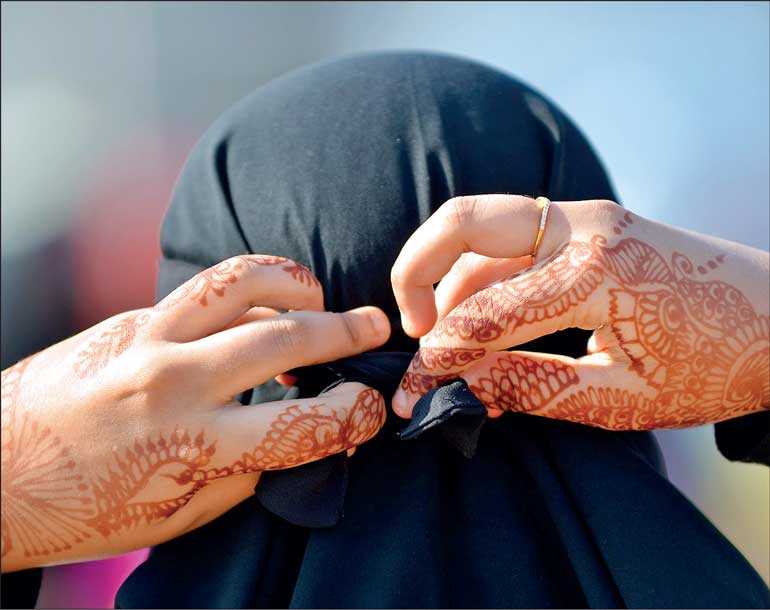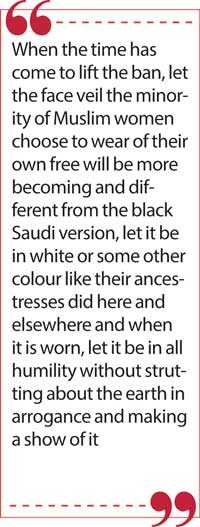Wednesday Apr 23, 2025
Wednesday Apr 23, 2025
Thursday, 30 May 2019 00:00 - - {{hitsCtrl.values.hits}}

There has perhaps been no garment that has aroused so much controversy as the niqab or face-veil worn by a small minority of Muslim women. Although worn by only a very small percentage of women, it is as conspicuous as can be and grabs attention wherever it is worn, making one wonder whether it is really for modesty as it is made out to be, or for attention.
Jokes apart, it is bound to come to the limelight again no sooner the State of Emergency is lifted. As we know, a ban was imposed on all forms of face coverings that prevented identification of persons as part of the State of Emergency following the Easter Sunday bombings. This was of course a very valid security concern and received the support of the Muslim community. The All Ceylon Jamiyyathul Ulama, the apex body of Islamic scholars in Sri Lanka, also supported it and in fact issued a statement requesting women not to wear it.
However, the question now is, will the ban ever outlive its purpose? Would the reappearance of the niqab still pose a security threat? What are the other implications of the niqab when it makes its appearance again? These are questions that need serious answers.
My personal feeling is that niqab ought to be a matter of choice, as in other things. However, there are some factors that militate against this ideal, which I shall deal with here. But first let us see if the face covering is really obligatory as some extremist scholars claim. In fact, it is the claim that it is obligatory that has been used to foist the niqab on unsuspecting women. So let’s see how far this claim is true.
Religious basis
There is no doubt that Islam prescribes a dress code for both men and women. For men it is the portion extending from the navel to the knees which is the minimum that must be covered. For women it is the entire body except for the face and hands. Prophet Muhammad (Peace Be Upon Him) made it very clear that every part of a woman should be covered when in the presence of a non-related male save for her face and hands.
Ayisha, the Prophet’s wife has narrated that when her sister Asma once came to see him, she was wearing a thin dress. The Prophet turned away from her and said to her: “O Asma, once a woman reaches the age of puberty no part of her body should be uncovered except this and this” and he pointed to the face and hands (Abu Dawud).
However, there is nothing wrong in covering more for purposes of modesty and this has been left to the choice of the woman concerned. However, what we are concerned about is whether it is obligatory. A renowned scholar of Islam, Sheikh Nasiruddin Al-Albani undertook a very comprehensive study of this in his treatise Jilbab al-Mar’ah Al-Muslimah (1996). He showed that the covering of the face was not obligatory for ordinary Muslim women and marshalled much evidence to support his contention.
Many incidents from the lifetime of the Prophet and the early caliphs bear this out. Thus when Al-Fadl Bin Abbas was riding behind the Prophet on his camel, a beautiful woman from the tribe of Khatham arrived, seeking a verdict from the Prophet. Al-Fadl began looking at her as her beauty attracted him and the Prophet noticing this held out his hand backwards, catching the chin of Al-Fadland turning his face (to the other side) so that he would not gaze at her (Sahih Al Bukhari). All this shows that the woman concerned was unveiled and the Prophet did not rebuke her for being so.
It is also related that when the Prophet was preaching to a group of women on Eid day, a woman with a dark spot on her cheek stood up seeking clarification of a matter (Saheeh Muslim) showing that she too was unveiled even in the presence of the Prophet. This was even the case in the days of the early caliphs. Thus when Umar attempted to forbid people from paying excessive dowers, a flat-nosed woman from among the women of the audience is said to have stood up, successfully challenging his decision (Ibn Al Jawzi) and again it may be argued that the woman concerned was unveiled since there could not have been any way for the others to know that she was flat-nosed.
The Qur’an too presupposes a society where women are not necessarily veiled, as in the verses: “Tell the believing men to lower their gaze and be mindful of their chastity. This will be most conducive to their purity. Verily, God is aware of all that they do. And tell the believing women to lower their gaze and to be mindful of their chastity, and not to display their charms (in public) beyond what may be apparent thereof” (Surah An-Nur: 30-31).
That the Qur’an should instruct men to lower their gaze when in the presence of strange women itself suggests that it was permissible for women to go about unveiled, for otherwise there would have been no reason for the Qur’an to command thus. It is also reported that when a well-known companion of the Prophet, Ibn Abbas was asked about the verse regarding women not displaying their charms except what appears thereof, he replied: “it refers to the face and hands” (Al-Musannaf, Ibn Abi Shaybah, Sunan Al-Kubra, Baihaqi).
Evidence from the sayings of the Prophet too could be cited in support of this view. For instance the Prophet’s statement, “The Muhrima (a woman in the state of ihram, i.e.the attire of one performing the pilgrimage) should not cover her face or wear gloves” (Saheeh Bukhari). It may be argued here that anything that is haram (prohibited) in the normal course of life can never be made fard (obligatory). Hence, if exposing the face was in fact prohibited for women, then how could it be made obligatory in ihram? This again shows that veiling the face is not an obligatory requirement in Islam.
In fact Sheikh Albani did not stop at that. He went on to expose the devious agenda of the extremist Saudi-based scholars who used futile and misleading arguments to push their view that it was obligatory.
Interestingly, a well-known translation of the Quran sponsored by Saudi Arabia which is freely available locally, ‘The Noble Qur’an’ by Muhsin Khan and Taqiuddin Hilali has inserted the translators’ personal views on to the text of the translation by inserting brackets. This is apparent in verse 31 of Surah An Nur: “And tell the believing women to lower their gaze and protect their private parts (from illegal sexual acts) and not to show off their adornment except only that which is apparent (like palms of hands, or one eye or both eyes for necessity to see the way) and to draw their veils all over (their bodies, faces, necks and bosoms, etc.).”
Now, this is a very unethical thing to do. If the translators wished to elaborate on the verse in question, they could have easily mentioned it as their personal opinion in a footnote as they have done elsewhere, but here they had surreptitiously inserted it in the body of the text itself so that credulous readers would come to believe that the Qur’an was commanding women to be veiled. This is nothing short of blasphemy, inserting one’s words into the Holy Word of God.
We see a similar pattern even here in Sri Lanka. I was informed by a friend that his young daughter who was teaching at a leading international Muslim girls school in Colombo had, a couple of years ago, fallen victim to a senior female teacher there who had prevailed on her to don the niqab despite the objections of her father. One finds many such insidious campaigns to promote niqab going on even as we speak.
Is niqab really a good idea?
Proponents promote niqab as a means of promoting chastity and preventing the lustful gaze of males and its attendant evils. However this premise is faulty because God clearly tells us in the Qur’an to lower our gaze. So it this divine command that we must follow rather than trying to control our feelings by putting the burden on women. This is in the fitness of things, because this earthly life with its entrapments, as we all know, is a test, and he or she that passes it without falling victim to it is on the right path.
Furthermore, there have been keen observers who have noted that a lot of vices do take place in societies where women are all covered up. This is because of the anonymity it gives. In fact, there are those who call it ‘liberating’ because a woman thus attired could indulge in adulterous affairs in utmost secrecy without her husband as much as suspecting it. Thus one wonders whether it is really such a good idea to ensure chastity.
The niqab poses other ethical challenges as well. Not the least is that it tends to give wearers a sense of arrogance and a ‘holier than thou’ attitude towards other women, especially other Muslim women, who do not wear it. To cite just one example my family experienced about 10 years ago. I was at this clinic going through a cupping session and my wife and daughter, who was then about five years, were seated outside.
A niqabi sat herself beside them, and my daughter, curious as to the exotic garment which in her little mind conjured up images of a ninja fighter, turned to her mother and innocently said that when she grew up she would like to dress just like her. Pat came the reply from the lady: “Good darling, then you can go to heaven!” Imagine that! She was implying my hijab-clad wife was going to go to hell.
She was also making a very misleading statement to a young, impressionable mind – that one could go to paradise by simply wearing a niqab as if nothing else mattered. So one wonders what use are our prayers, our charity and our sacrifices for kith and kin if we can simply earn God’s pleasure by focusing on an external matter such as this?
There are other concerns as well. Among these is the effacement of women in the public sphere. How would one know one woman from the other? This is so because the face is the marker of identity. This is why ID cards always bear the photograph of one’s face. This becomes all the more pressing when a woman achieves something in life. When she speaks the audience needs to know whether it’s her that’s speaking. Invigilators must know whether the female student at the desk is the person she claims to be. The judge must see who the female witness in the box is. Indeed, one may ask, can society function properly in an environment where women are veiled from top to toe?
In the local context, the problem is more pronounced because the majority of Sri Lankans – Muslims included – look upon it as something alien. They very rightfully believe it to be an imposition from Saudi Arabia that made its  appearance in the past 30 years or so. Some argue that Muslim women of a couple of generations ago were veiled, but this did not take the form of the black niqab peculiar to Saudi Arabia and certain parts of India. The veil local upper class Muslim women wore comprised of a long velvet gown and a velvet cap with thin chiffon or georgette material that could be let down when in the presence of strange men but which enabled the wearer to see and also enabled others to make out who she was at a close distance. The women of the more humble classes wore a tuppatti, a long white cloth which they wrapped all over their bodies when going out, but not necessarily covering the face.
appearance in the past 30 years or so. Some argue that Muslim women of a couple of generations ago were veiled, but this did not take the form of the black niqab peculiar to Saudi Arabia and certain parts of India. The veil local upper class Muslim women wore comprised of a long velvet gown and a velvet cap with thin chiffon or georgette material that could be let down when in the presence of strange men but which enabled the wearer to see and also enabled others to make out who she was at a close distance. The women of the more humble classes wore a tuppatti, a long white cloth which they wrapped all over their bodies when going out, but not necessarily covering the face.
As such, the niqab as we know it today tends to create an aversion towards its wearers on the part of the majority of our people. One only has to see the notices in the shops screaming away ‘No niqab, no burka’ and the look of ordinary people on the streets when they see a woman strutting about with it. It is looked upon not only as being alien, but exclusive as well, creating an aversion such as the Jews of the Middle Ages invited in Europe with their exclusivity and as a result suffered its consequences. As such, one cannot imagine that Islam would have ever made such an attire obligatory. Islam is about winning hearts, not about driving people away from it.
Thus, let those who are calling for its return think twice before it makes its reappearance, and let them think of its implications as well. Only fools rush to do things without thinking of its consequences. When the time has come to lift the ban, let the face veil the minority of Muslim women choose to wear of their own free will be more becoming and different from the black Saudi version, let it be in white or some other colour like their ancestresses did here and elsewhere and when it is worn, let it be in all humility without strutting about the earth in arrogance and making a show of it.
Discover Kapruka, the leading online shopping platform in Sri Lanka, where you can conveniently send Gifts and Flowers to your loved ones for any event including Valentine ’s Day. Explore a wide range of popular Shopping Categories on Kapruka, including Toys, Groceries, Electronics, Birthday Cakes, Fruits, Chocolates, Flower Bouquets, Clothing, Watches, Lingerie, Gift Sets and Jewellery. Also if you’re interested in selling with Kapruka, Partner Central by Kapruka is the best solution to start with. Moreover, through Kapruka Global Shop, you can also enjoy the convenience of purchasing products from renowned platforms like Amazon and eBay and have them delivered to Sri Lanka.
Discover Kapruka, the leading online shopping platform in Sri Lanka, where you can conveniently send Gifts and Flowers to your loved ones for any event including Valentine ’s Day. Explore a wide range of popular Shopping Categories on Kapruka, including Toys, Groceries, Electronics, Birthday Cakes, Fruits, Chocolates, Flower Bouquets, Clothing, Watches, Lingerie, Gift Sets and Jewellery. Also if you’re interested in selling with Kapruka, Partner Central by Kapruka is the best solution to start with. Moreover, through Kapruka Global Shop, you can also enjoy the convenience of purchasing products from renowned platforms like Amazon and eBay and have them delivered to Sri Lanka.